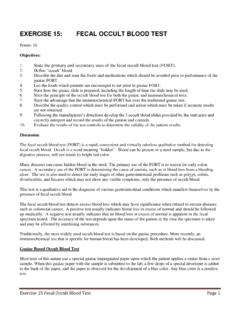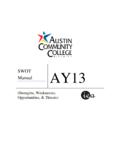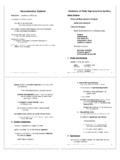Transcription of Zoology Lab Manual - Austin Community College District
1 Biology 1413 Introductory Zoology Supplement to Lab Manual ; Ziser 1 General Zoology Lab Supplement Stephen W. Ziser Department of Biology Pinnacle Campus To Accompany the Zoology Lab Manual : Smith, D. G. & M. P. Schenk Exploring Zoology : A Laboratory Guide. Morton Publishing Co. for BIOL 1413 General Zoology Biology 1413 Introductory Zoology Supplement to Lab Manual ; Ziser 2 General Zoology Laboratory Exercises 1. Orientation, Lab Safety, animal Collection .. 3 2. Lab Skills & Microscopy .. 14 3. animal Cells & Tissues .. 15 4. animal Organs & Organ Systems .. 17 5. animal Reproduction .. 25 6. animal Development .. 27 7. Some animal -Like Protists .. 31 8. The animal Kingdom .. 33 9. Phylum Porifera (Sponges) .. 47 10. Phyla Cnidaria (Jellyfish & Corals) & Ctenophora .. 49 11. Phylum Platyhelminthes (Flatworms) .. 52 12.
2 Phylum Nematoda (Roundworms) .. 56 13. Phyla Rotifera .. 59 14. Acanthocephala, Gastrotricha & Nematomorpha .. 60 15. Phylum Mollusca (Molluscs) .. 67 16. Phyla Brachiopoda & Ectoprocta .. 73 17. Phylum Annelida (Segmented Worms) .. 74 18. Phyla Sipuncula .. 78 19. Phylum Arthropoda (I): Trilobita, Myriopoda .. 79 20. Phylum Arthropoda (II): Chelicerata .. 81 21. Phylum Arthropods (III): Crustacea .. 86 22. Phylum Arthropods (IV): Hexapoda .. 90 23. Phyla Onycophora & Tardigrada .. 97 24. Phylum Echinodermata (Echinoderms) ..104 25. Phyla Chaetognatha & Hemichordata .. 108 26. Phylum Chordata (I): Lower Chordates & Agnatha .. 109 27. Phylum Chordata (II): Chondrichthyes & Osteichthyes .. 112 28. Phylum Chordata (III): Amphibia .. 115 29. Phylum Chordata (IV): Reptilia .. 118 30. Phylum Chordata (V): Aves .. 121 31. Phylum Chordata (VI): Mammalia .. 124 Lab Reports & Assignments Identifying animal Phyla.
3 39 Identifying Common Freshwater Invertebrates .. 42 Lab Report for Practical #1 .. 43 Lab Report for Practical #2 .. 62 Identification of Insect Orders .. 96 Lab Report for Practical #3 .. 98 Lab Report for Practical #4 .. 130 Biology 1413 Introductory Zoology Supplement to Lab Manual ; Ziser 3 Biol 1413 Lab Orientation The laboratory portion of this course is designed to study anatomical details of of animals in general or common examples of specific phyla more thoroughly than it is presented in lecture. This method of hands on learning should also enhance and strengthen the knowledge you gain in lectures. Most of the time you will be working individually or in pairs. There is sometimes not enough time in lab to go over each and every item that you are assigned. The lab is a designated a time when you have access to materials that you will not have available during home study time.
4 Some of the information assigned in lab you can learn at home, other items, particularly anatomical terms identified on dissected organs, animals and models and microscopic details viewed with a microscope can only be learned adequately in the lab room. The lab period will begin with a short introduction and orientation to the material to be studied. I will assume that you have read the exercise before you come to lab. I will point out which models, preserved animals and slides we have available for the lesson as well as any changes to the procedures. The rest of the lab time is yours to begin learning the material, view any assigned slides and perform any dissections that are required. All dissecting tools will be provided for you, you do not need to buy a dissecting kit. We have a small supply of latex gloves available for the dissections. Biology 1413 Introductory Zoology Supplement to Lab Manual ; Ziser 4 Lab Reports Each student will complete a Lab Report (see Table of Contents)for the material covered in each of 4 Lab Practicals.
5 Lab reports are at the end of each section of material for each practical (see Table of Contents). Each lab report will include answers to specific questions from individual lab activities as well as general questions about the animal kingdom. You will also be asked to make sketches and observations about the slides and preserved materials that you are studying. You are also free to include any other materials (see below) that you think might be helpful to learn the information presented in the lab exercises and prepare yourself for the practical. These Lab Reports will be due on the day of the practical covering the same material. Drawings: 1. If you are sketching material without magnifcation or if you are switching back and forth between no magnification and slight magnification (eg. hand lens)you should draw a rectangular border around your sketch and indicate the actual size of the object being sketched.
6 2. if you are sketching material viewed through a microscope or a dissecting scope, trace a circular border in which to make your drawing (You might cut out a cardboard circle to use each time so they will be neatly done and all the same size). Make sure your drawing fills the circle to the same extent that the object actually appears through the microscope. Be sure to indicate the magnification being used for each sketch 3. More detailed information on drawing techniques can be found in the Collecting and Preserving Methods binder on the lab counter. If you want to try these more detailed directions, I ll be happy to make you a copy of the article What else you might want to include: Sketches of slide materials, models or preserved materials that will help you to study for the practicals. Any sketches should be labeled appropriately You might also want to include comments on the appearance or difficulty in finding and/or identifying the materials for study Any personal observations you made while completing the exercise or studying the material Special points to be aware of while reviewing the lab Remember that the function of these reports should be to help you organize your lab material and to facilitate learning it for the practical.
7 Biology 1413 Introductory Zoology Supplement to Lab Manual ; Ziser 5 General Zoology animal Collection You will make a small animal collection consisting of 5 different animals, from 5 different phyla or subphyla. You will NOT get these items back so please don t include a keepsake or treasure that you want to hold onto. ACC will provide nets, vials, jars, preservative, insect pins, some labels, etc. The goals for this collection are to: Learn to visually recognize some of the animals common to the area Learn something about the ecology and behavior of these animals Learn how to use identification manuals and keys Become acquainted with the taxonomy and classification of animals, and Learn how to properly preserve and label museum specimens You will be given more information on proper preservation and presentation of specimens in lab. You might also want to consult some Identification keys for the kinds of animals that you are interested in collecting.
8 The animal collection will be worth 50 points and is due the Monday of the last week of classes. Your grade for the collection will be based on the following criteria: diversity and originality of your collection ability to follow correct procedures for preserving and displaying specimensas described in the materials quality of the preservation technique accuracy of identification (usually to species) & common name You do not need to kill anything to make this collection. Some examples of the kinds of collections you can make: soil and leaf litter organisms aquatic organisms shells skeletons and/or skulls nests, burrows, tunnels, etc plaster casts of footprints or tracks photographs parasites fossils The preservation method that you choose depends on the type of collection that you do. For example: Permanent Slides: are used for small or microscopic animals 70% alcohol/10% formalin: is used for most invertebrates including insect larvae, larger invertebrates and some vertebrates will need to be injected Study Skins: for birds and mammals Dried Specimens: for bones, shells, nests, etc Pinned Specimens: adult insects are generally dried on insect pins and mounted in an insect box Each and every specimen must be properly labeled.
9 The type and location of the label depends on the kind of collection and preservation that you do. All labels must include the following information: Collection Locality (including nearest city) Date of collection General Habitat (eg. woods, pond, soil, treebark, grass, etc) Scientific Name & Common Name Your Name When in doubt ASK THE INSTRUCTOR. Biology 1413 Introductory Zoology Supplement to Lab Manual ; Ziser 6 Animals Preserving Techniques A Shortened Summary (More detailed instructions and suggestions can be found in the " Zoology animal COLLECTION AND TECHNIQUES" binder in 701) We can provide containers, vials or bags along with preservatives for your collection. We have several dozen identification guides for many kinds of central Texas animals. You can also find ID guides at the PIN Library and most public libraries in Austin . You can also find quite a lot of information by searching the web More information on proper collecting and preserving techniques are in a binder in the labroom.
10 More detailed Information on preserving various kinds of specimens: A. Animals collected live: Most invertebrates except those listed below: Kill and preserve in jars of 10% formalin solution or 70% alcohol (ethyl or isopropyl; make label with India ink and place inside jar Most insects except butterflies, moths and dragonflies: Kill in killing jar or freezer; pin properly; allow to dry; label should be no larger than 1"x1/2" and placed on pin below insect Butterflies, moths and dragonflies: Kill in killing jar or freezer; pin and arrange wings on spreading board or piece of styrofoam; allow to dry; label should be no larger than 1"x1/2" and placed on pin below insect Vertebrates except for birds and mammals ( : fish, frogs, salamanders, lizards, snakes, turtles) kill in freezer; fix and preserve in jar of 10% formalin solution; use syringe to inject formalin solution into the body cavity in several places.)










